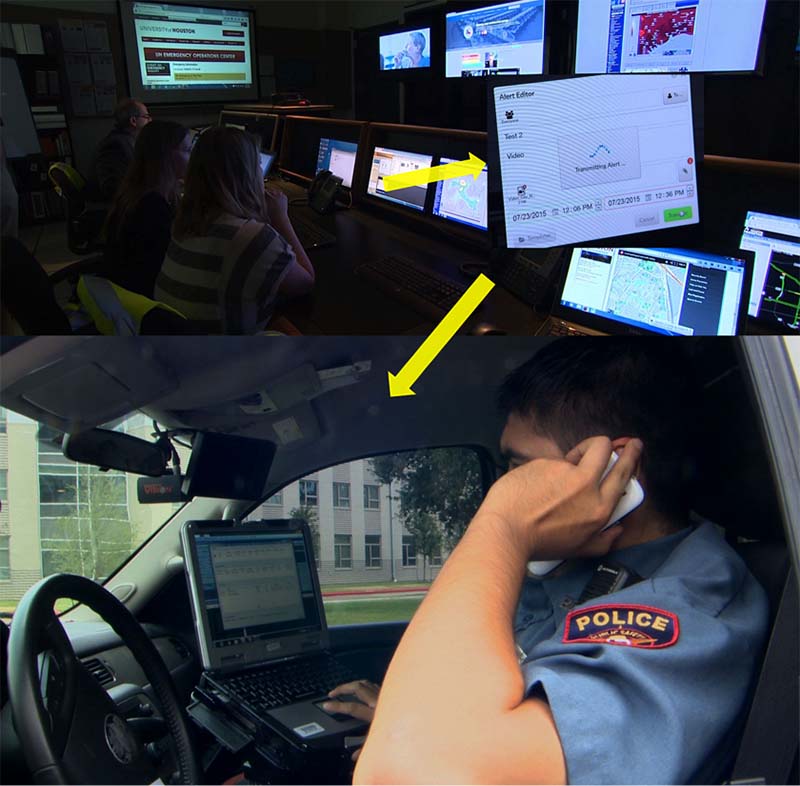
Datacasting pilot tests in Houston, including with the University of Houston, successfully showed that new technology could improve the amount and quality of information that emergency agencies could effectively deliver to a variety of agencies.
Credit: DHS S&T
Press Release
Datacasting Technology Gives First Responders More Secure, Better Information during Emergencies
A Johns Hopkins Applied Physics Laboratory-led program for the First Responders Group of the Department of Homeland Security (DHS), Science and Technology Directorate has created a successful new way for public safety agencies to get the information they need during a crisis.
Datacasting is a targeted, encrypted communications technology that can wirelessly deliver video and other data to specific recipients across a very wide area. It accomplishes this by using the broadcast frequencies of public television stations, which have expansive and reliable coverage over cities, towns and regions.
“Datacasting gives first responders the same broad access to data that we are all used to having on our smartphones,” explains John Contestabile, APL’s datacasting program manager. “Emergency voice communications are currently good, but they aren’t designed to handle large amounts of data. And, during an emergency, cellular networks become congested and strained from use by the public.”
By using the public television broadcast spectrum and equipment — a robust, proven system that’s been in use for almost 80 years — datacasting capitalizes on modern advances in data transmission and takes advantage of the high capacity and resilience of a time-tested broadcast technology. (This first became available for use in 2009, when over-the-air television transmissions switched to digital signals. The change created segments of unused bandwidth in the originally allocated television spectrum.)
Throughout 2015, a team of nearly half a dozen engineers and researchers from APL’s Asymmetric Operations Sector worked with a subcontractor, SpectraRep, to install equipment, then plan and execute successful datacasting pilot studies in two major U.S. cities (Chicago and Houston). The Houston datacasting trial received an award as the year’s best security technology innovation from a leading industry group. [See: http://www.securityinfowatch.com/article/12134323/city-of-houston-wins-2015-security-innovation-awards-top-prize]
“Once low-impact hardware is installed at the public television station, the first responders can use their existing computers to get all the data and video that the local emergency management agency sends out,” said Mark O’Brien, president of SpectraRep. “A big issue during emergencies is getting the same information at the same time to a wide group of responders, which may all be using slightly different traditional communications systems. Datacasting helps to solve that.”
One of the main assets of datacasting is the ability to deliver secure, high-quality video to emergency services personnel. “Getting that ‘eyes-on’ look at a situation or specific location is a huge help to the first responders,” says Jack Hanagriff of the Houston Police Department. “Having that real-time, crucial video, delivered reliably, lets the different teams know what they’re heading for, and how to prepare for it.”
DHS S&T Program Manager Cuong Luu plans to conduct another pilot program in 2016, in a city to be determined, to further assess the capabilities of datacasting.
“Datacasting has a lot of benefits that fit perfectly with the needs of the first responder community,” Contestabile said. “It delivers a variety of information reliably to a wide group of agencies. It doesn’t put a load on other communications systems, and in fact reduces demands on cellular networks — which is critical in a large-scale emergency. And the broadcasting agency can precisely target who gets the information, and even retains control over it after it’s been sent. That means they can delete data from remote systems if a breach or theft occurs.”
APL compiled two comprehensive reports on the Houston and Chicago pilots for DHS S&T; they can be read here: